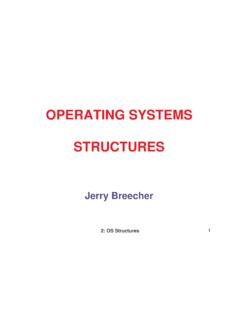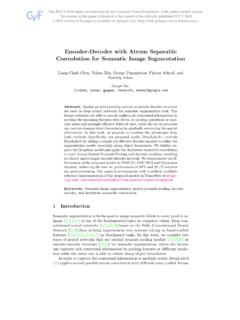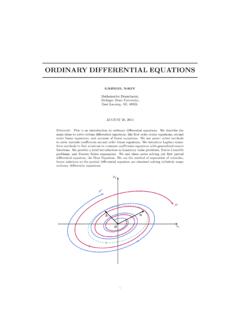Transcription of Digital Image Processing (CS/ECE 545) Lecture Filters ...
1 Digital Image Processing (CS/ECE 545) Lecture 4: Filters (Part 2) & Edges and ContoursProf Emmanuel AguComputer Science Polytechnic Institute (WPI)Recall: Applying Linear Filters : Convolution1. Move filter matrix H overimage such that H(0,0) coincides with current imageposition (u,v)For each Image position I(u,v):2. Multiply all filter coefficients H(i,j)with corresponding pixelI(u + i, v + j)3. Sum up results and store sum in corresponding positionin new Image I (u, v)Stated formally:RHis set of all pixels Covered by 3x3 filter, this is:Recall: Mathematical Properties of Convolution Applying a filter as described called linear convolution For discrete 2D signal, convolution defined as: Recall: Properties of Convolution Commutativity Linearity(notice) AssociativitySame result if we convolve Image with filter or vice versaIf Image multiplied by scalarResult multiplied by same scalarIf 2 images added and convolveresult with a kernel H, Same result if we each imageis convolved individually + addedOrder of filter application irrelevantAny order, same resultProperties of Convolution Separability If a kernel H can be separated into multiple smaller kernels Applying smaller kernels H1H2.
2 HNH one by onecomputationally cheaper than apply 1 large kernel HComputationallyMore expensiveComputationallyCheaperSeparabil ity in x and y Sometimes we can separate a kernel into vertical and horizontal components Consider the kernelsComplexity of x/y separable Kernels What is the number of operations for 3 x 5 kernel HAns: 15wh What is the number of operations for Hxfollowed by Hy?Ans: 3wh + 5wh= 8whComplexity of x/y separable Kernels What is the number of operations for 3 x 5 kernel HAns: 15wh What is the number of operations for Hxfollowed by Hy?Ans: 3wh + 5wh= 8wh What about M x M kernel?O(M2) no separability (M2wh operations, grows quadratically!)O(M2) with separability (2 Mwh operations, grows linearly!)Gaussian Kernel 1D 2 DSeparability of 2D Gaussian 2D gaussian is just product of 1D gaussians: separable !Separability of 2D Gaussian Consequently, convolution with a gaussian is separable Where G is the 2D discrete gaussian kernel; Gxis horizontal and Gyis vertical 1D discrete Gaussian kernelsImpulse (or Dirac) Function In discrete 2D case, impulse function defined as: Impulse function on Image ?
3 A white pixel at origin, on black backgroundImpulse (or Dirac) Function Impulse function neutral under convolution (no effect) Convolving an Image using impulse function as filter = imageImpulse (or Dirac) Function Reverse case? Apply filter H to impulse function Using fact that convolution is commutative Result is the filter HNoise While taking picture (during capture), noise may occur Noise? Errors, degradations in pixel values Examples of causes: Focus blurring Blurring due to camera motion Additive model for noise: Removing noise called Image Restoration Image restoration can be done in: Spatial domain, or Frequency domainTypes of Noise Type of noise determines best types of Filters for removing it!! Salt and pepper noise: Randomly scattered black + white pixels Also called impulse noise, shot noise or binary noise Caused by sudden sharp disturbanceCourtesy Allasdair McAndrewsTypes of Noise Gaussian Noise: idealized form of white noise added to Image , normally distributed Speckle Noise: pixel values multiplied by random noiseCourtesy Allasdair McAndrewsTypes of Noise Periodic Noise: caused by disturbances of a periodic nature Salt and pepper, gaussian and speckle noise can be cleaned using spatial Filters Periodic noise can be cleaned using frequency domain filtering (later)Courtesy Allasdair McAndrewsNon Linear Filters Linear Filters blurs all Image structures points, edges and lines, reduction of Image quality (bad!)
4 Linear Filters thus not used a lot for removing noiseSharpedgeSharpThinLineBlurredEdgeRe sultsBlurredThinLineResultsApply LinearFilterUsing Linear Filter to Remove Noise? Example: Using linear filter to clean salt and pepper noise just causes smearing (not clean removal) Try non linear Filters ?Courtesy Allasdair McAndrewsNon Linear Filters Pixels in filter range combined by some non linear function Simplest examples of nonlinear Filters : Min and Max filtersBeforefilteringAfterfilteringStep Edge(shifted to right)NarrowPulse(removed)Linear Ramp(shifted to right)Effect ofMinimum filterNon Linear FiltersOriginal Image withSalt-and-pepper noiseMinimum filter removesbright spots (maxima) andwidens dark Image structuresMaximum filter (opposite effect):Removes dark spots (minima) andwidens bright Image structuresMedian Filter Much better at removing noise and keeping the structuresSort pixel values within filter region Replace filter hot spot pixelwith median of sorted valuesIllustration.
5 Effects of Median FilterIsolated pixels are eliminatedA step edge isunchangedA corner is rounded offThin lines are eliminatedEffects of Median FilterOriginal Image withSalt-and-pepper noiseLinear filter removes some ofthe noise, but not noiseMedian filter salt-and-pepper noiseand keeps Image structures largelyintact. But also creates small spotsof flat intensity, that affect sharpness Median Filter ImageJ PluginGet Image width + height,and Make copy of imageArray to store pixels to be filtered. Gooddata structure in which to find medianCopy pixels within filter region into arraySort pixels within filter usingjava utility ( )Middle (k) element of sorted array assumed to be middle. Return as medianWeighted Median Filter Color assigned by median filter determined by colors of the majority of pixels within the filter region Considered robust since single high or low value cannot influence result (unlike linear average) Median filter assigns weights (number of votes ) to filter positions To compute result, each pixel value within filter region is inserted W(i,j)times to create extended pixel vector Extended pixel vector then sorted and median returnedWeighted Median FilterWeight matrixPixels within filter regionInsert each pixel within filter region W(I,j) times into extended pixel vectorSort extended pixel vector and return medianNote: assigning weight to center pixel larger than sum of all other pixel weights inhibits any filter effect (center pixel always carries majority)!
6 !Weighted Median Filter More formally, extended pixel vector defined as For example, following weight matrix yields extended pixel vector of length 15 (sum of weights) Weighting can be applied to non rectangular Filters Example: cross shaped median filter may have weightsAn Outlier Method of Filtering Algorithm by Pratt, Ref: Alasdair McAndrew, Page 116 Median filter does sorting per pixel (computationally expensive) Alternate method for removing salt and pepper noise Define noisy pixels as outliers(different from neighboring pixels by an amount > D) Algorithm: Choose threshold value D For given pixel, compare its value p to mean m of 8 neighboring pixels If |p m| > D, classifiy pixel as noise, otherwise not If pixel is noise, replace its value with m; Otherwise leave its value unchanged Method not automatic. Generate multiple images with different values of D, choose the best looking oneOutlier Method Example Effects of choosing different values of D D value of performs best Overall outlier method not as good as median filterD value too small: removes noise from dark regionsD value too large: removes noise from light regionsCourtesy Allasdair McAndrewsOther Non Linear Filters Any filter operation that is not linear (summation), is considered linear Min, max and median are simple examples More examples later: Morphological Filters (Chapter 10) Corner detection Filters (Chapter 8) Also, filtering shall be discussed in frequency domainExtending Image Along BordersPad: Set pixels outsideborder to a constantMirror: pixels aroundimage borderPad: Set pixels outsideborder to a constantWrap: repeat pixels periodically along coordinate axesExtend.
7 Pixels outsideborder take on value ofclosest border pixelFilter Operations in ImageJ Linear Filters implemented by ImageJ plugin class Has several methods in addition to run( )Define filter matrixCreate new instance ofConvolver classApply filter (Modifies Image I destructively)Gaussian Filters gaussian filter with radius ( ) Uses separable 1d gaussiansCreate new instance ofGaussianBlur classBlur Image ip with gaussian filter of radius r Non Linear Filters A few non linear Filters (minimum, maximum and median Filters implemented in Filter region is approximately circular with variable radius Example usage:Recall: Linear Filters : ConvolutionConvolution as a Dot Product Applying a filter at a given pixel is done by taking dot product between the Image and some vector Convolving an Image with a filter equal to: Filter each Image window (moves through Image )Dot productDigital Image Processing (CS/ECE 545) Lecture 4: Filters (Part 2) & Edges and ContoursProf Emmanuel AguComputer Science Polytechnic Institute (WPI)What is an Edge?)
8 Edge? sharp change in brightness (discontinuities) Where do edges occur? Actual edges: Boundaries between objects Sharp change in brightness can also occur within object Reflectance changes Change in surface orientation Illumination changes. Cast shadow boundaryEdge Detection Image Processing task that finds edges and contours in images Edges so important that human vision can reconstruct edge linesCharacteristics of an Edge Edge: A sharp change in brightness Ideal edge is a step function in some directionCharacteristics of an Edge Real (non ideal) edge is a slightly blurred step function Edges can be characterized by high value first derivativeRising slope causes positive + high value first derivativeFalling slope causes negative + high value first derivativeCharacteristics of an Edge Ideal edge is a step function in certain direction. First derivative of I(x) has a peak at the edge Second derivative of I(x) has a zero crossing at edgeIdeal edgeReal edgeFirst derivativeshows peakSecond derivativeshows zero crossingSlopes of Discrete Functions Left and right slope may not be same Solution?
9 Take average of left and right slopeComputing Derivative of Discrete FunctionActual slope (solid line)Estimated slope (dashed line)Finite Differences Forward difference (right slope) Backward difference (left slope) Central Difference (average slope)Definition: Function Gradient Let f(x,y) be a 2D function Gradient: Vector whose direction is in direction of maximum rate of change of f and whose magnitude is maximum rate of change of f Gradient is perpendicular to edge contourImage Gradient Image is 2D discrete function Image derivatives in horizontal and vertical directions Image gradient at location (u,v) Gradient magnitude Magnitude is invariant under imagerotation, used in edge detectionDerivative Filters Recall that we can compute derivative of discrete function as Can we make linear filter that computes central differencesFinite Differences as Convolutions Forward difference Take a convolution kernelFinite Differences as Convolutions Central difference Convolution kernel is: Notice.
10 Derivative kernels sum to zerox Derivative of Image using Central Differencey Derivative of Image using Central DifferenceDerivative FiltersA syntheticimageMagnitude ofgradientGradient slope in vertical directionGradient slope in horizontal directionEdge Operators Approximating local gradients in Image is basis of many classical edge detection operators Main differences? Type of filter used to estimate gradient components How gradient components are combined We are typically interested in Local edge direction Local edge magnitudePartial Image Derivatives Partial derivatives of images replaced by finite differences Alternatives are: Robert s gradientPrewittSobelUsing Averaging with Derivatives Finite difference operator is sensitive to noise Derivates more robust if derivative computations are averaged in a neighborhood Prewitt operator: derivative in x, then average in y y derivative kernel, defined similarlyAverage in ydirectionDerivative in xdirectionNote: Filter kernel is flipped in convolutionSobel Operator Similar to Prewitt, but averaging kernel is higher in middleAverage in xdirectionDerivative in ydirectionNote.











